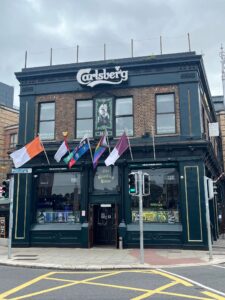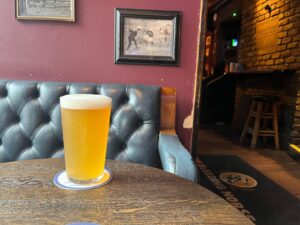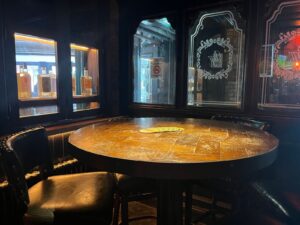 As regular readers know, we are always on the lookout for a pub with a good ghost story, whether it’s October or, really, any time. The pub in question we’re visiting this week doesn’t feel particularly spooky, but it does have an interesting history to go along with the ghost story, even if they aren’t perfectly well-connected. Without further ado, we make our way to The Portobello Bar.
As regular readers know, we are always on the lookout for a pub with a good ghost story, whether it’s October or, really, any time. The pub in question we’re visiting this week doesn’t feel particularly spooky, but it does have an interesting history to go along with the ghost story, even if they aren’t perfectly well-connected. Without further ado, we make our way to The Portobello Bar.
 While the ‘since 1793’ date is a little shaky, given the current building’s construction in the 1870s, it seems entirely plausible that there was, indeed, an inn or pub around here earlier. The Grand Canal’s proximity – just across a heavily-used road – supports the possibility of an earlier date, and it’s also what supplies our ghost story. Construction began on the Grand Canal in the late 18th century, and it was a key piece of infrastructure in the 19th and early 20th centuries. Our ghost – a ‘vengeful’ or ‘drunken’ lock-keeper (take your pick/why not both?) – is alleged to originate in the middle of the 19th century, forever haunting the lock just outside the pub. He’s even meant to be responsible for multiple deaths, appearing as a shapeshifting light-into-human-figure. As an aside, we don’t get enough shapeshifting ghostlore any more – there used to be a proud tradition of spooks turning into hay bales or cows and horses, and that seems to have vanished in modern ‘it happened to me stories’ – someone should get on that. But we digress…
While the ‘since 1793’ date is a little shaky, given the current building’s construction in the 1870s, it seems entirely plausible that there was, indeed, an inn or pub around here earlier. The Grand Canal’s proximity – just across a heavily-used road – supports the possibility of an earlier date, and it’s also what supplies our ghost story. Construction began on the Grand Canal in the late 18th century, and it was a key piece of infrastructure in the 19th and early 20th centuries. Our ghost – a ‘vengeful’ or ‘drunken’ lock-keeper (take your pick/why not both?) – is alleged to originate in the middle of the 19th century, forever haunting the lock just outside the pub. He’s even meant to be responsible for multiple deaths, appearing as a shapeshifting light-into-human-figure. As an aside, we don’t get enough shapeshifting ghostlore any more – there used to be a proud tradition of spooks turning into hay bales or cows and horses, and that seems to have vanished in modern ‘it happened to me stories’ – someone should get on that. But we digress…
But there was a very real tragedy just opposite the pub’s location in 1861, when a horse-drawn omnibus went off the nearby bridge into the canal, killing all the passengers as well as both horses. While ‘some’ attributed the accident to the spectral lock-keeper, it would be an interesting exercise to trace back the origin of that part of the story, especially since the current pub (or, at least, most of it) would have been built or re-built at least a good few years after the accident.
 So, ghosts aside, what is the pub like? Well…most definitely not creepy. If anything, it’s a bit too polished to feel at all like a liminal space. There are several very different sections of the pub with their own character, but none are especially dark or gloomy. The front is much more ‘pubby’ and the rear more of a restaurant or hotel bar vibe (the many large TV screens are part of what gives that impression), though it’s worth knowing that the back bar is where the sole local-craft-beer representative is; there’s a Rye River tap if you know where to look. Indeed, the food was very good – a step up from a lot of pub food, though the enormous portions are perhaps created more for tourists than locals. There’s also the usual Guinness – and Murphy’s – plus some Warsteiner.
So, ghosts aside, what is the pub like? Well…most definitely not creepy. If anything, it’s a bit too polished to feel at all like a liminal space. There are several very different sections of the pub with their own character, but none are especially dark or gloomy. The front is much more ‘pubby’ and the rear more of a restaurant or hotel bar vibe (the many large TV screens are part of what gives that impression), though it’s worth knowing that the back bar is where the sole local-craft-beer representative is; there’s a Rye River tap if you know where to look. Indeed, the food was very good – a step up from a lot of pub food, though the enormous portions are perhaps created more for tourists than locals. There’s also the usual Guinness – and Murphy’s – plus some Warsteiner.
 There’s a covered outdoor space too, more Pavement Pints than beer garden, given the amount of traffic nearby, but you do get a view of the canal lock and the (haunted?) bridge. And even if you’re not into the ghostly folklore, The Portobello Bar does have other legitimate historical claims: back when it was called Davy’s, it was an important site during the Easter Rising in 1916, and that history is very much remembered in this pub.
There’s a covered outdoor space too, more Pavement Pints than beer garden, given the amount of traffic nearby, but you do get a view of the canal lock and the (haunted?) bridge. And even if you’re not into the ghostly folklore, The Portobello Bar does have other legitimate historical claims: back when it was called Davy’s, it was an important site during the Easter Rising in 1916, and that history is very much remembered in this pub.
We may not have seen the vengeful lock-keeper at The Portobello Bar, but we did have a good burger and pint. We’ll keep trying to find some good haunted Dublin pub stories…
Where: 33 South Richmond St, Dublin, IE D02 CF40
Access from the city centre: Buses 9, 15, 15A, 15B, 16, 83, 83A, 140; 25-ish minute walk
Food: Elevated pub grub, carvery, weekend brunch
Sport: All the sport, football especially
TVs: So many large screens in the back that it can feel a bit sports-bar-y
Music: DJs and live music at weekends
Family-friendliness: At the usual times
Pub-crawl-ability: High – Camden street is full of pubs and bars like The Bleeding Horse, Devitt’s, Teach Tábhairne Ag Teach, The Camden, Whelan’s, Anseo, Ryan’s of Camden Street…and the local ‘Spoon’s, Keavan’s Port
Local sites of note: Iveagh Gardens, St Stephen’s Green, National Concert Hall, St Kevin’s Park, Grand Canal
Haunted: Is it the lock-keeper? The tram passengers? The horses? Everything to play for here
Other notes: Main-floor toilets, though no specific disabled toilet
Socials: Facebook, Instagram


 The Bleeding Horse gets the usual James Joyce namecheck in Ulysses, complete with a stone at the door to remind the visitor, but I’m personally more interested in the
The Bleeding Horse gets the usual James Joyce namecheck in Ulysses, complete with a stone at the door to remind the visitor, but I’m personally more interested in the  A 17th century ale-house would have been somewhat akin to our modern ‘wet pub’ (yes, it’s a terrible phrase), with drink on offer, but little else, while an inn would have offered accommodation as well as refreshment. And although ‘public houses’
A 17th century ale-house would have been somewhat akin to our modern ‘wet pub’ (yes, it’s a terrible phrase), with drink on offer, but little else, while an inn would have offered accommodation as well as refreshment. And although ‘public houses’ 